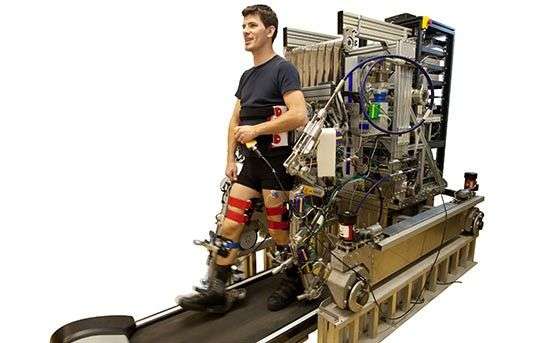Rehabilitation robot could help stroke sufferers learn how to walk again

Stroke sufferers could learn to walk again with a ground-breaking robot developed, in part, by scientists from the University of Hertfordshire.
At the moment, if a stroke patient is struggling to walk, multiple physiotherapists are needed to help support them and manually correct their gait on a treadmill.
But this process could become a thing of the past with the development of the CORBYS gait rehabilitation system.
The state-of-the-art exoskeleton works and adapts with the patient to provide individualised therapy overseen by 1 professional.
Several modes are available on the CORBYS system – which has 16 degrees of freedom - and therapists can use them to tailor treatment.
Adapts
It also provides a full range of movement and adapts to users' disabilities and constraints.
The machine - which is roughly the size of a forklift truck - could also be used to help people who have suffered serious head injuries walk again.
Therapy sessions could also be extended as a patient working with the robot would only be restrained by their own limitations, instead of the fatigue of their therapists.
6 of the University's scientists were instrumental in the project and were the main authors of a paper, which will be presented at the prestigious International Conference on Intelligent Robots and Systems in Hamburg this week.
Dr Christoph Salge worked alongside his Hatfield-based colleagues Cornelius Glackin, Martin Greaves, Nicola Catenacci Volpi, Dari Trendafilov and Daniel Polani on the gait robot.
Therapist
'This could help reducing pressure on repetitive tasks of the therapist during rehabilitation of stroke and other patients and improve the general availability of the therapist for required interventions,' said Dr Polani.
The robot works by measuring patients' gaits in one setting where no restrictions are imposed, therapists can then study how they walk and manipulate the movement.
In the Corrective Operating Mode the patient can walk on the treadmill constrained by the robotic system, which can be tweaked and modified by the therapist.
The publication of the paper is the culmination of a 4 year research effort within the European Union-funded 6.1 million Euro project CORBYS.
Rehabilitation
The CORBYS project united universities and companies from across Europe to 'design, develop and validate an integrated cognitive robot control architecture for supporting robot-human co-working with high level cognitive capabilities.'
Dr Polani added: 'At the heart of the project was the development of an architecture which allows adaptable control of robots in different situations.
'Rehabilitation is a particularly good example for the flexibility of the architecture.'
Provided by University of Hertfordshire




















